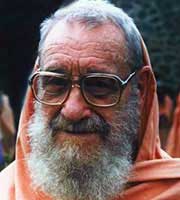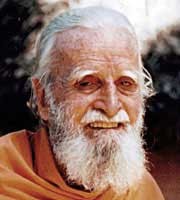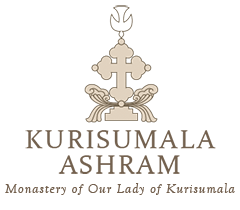
Fr. FRANCIS ACHARYA OCSO
(17.01.1912 - 31.01.2002)

Fr. BEDE GRIFFITHS OSB
(17.12.1906 - 13.05.1993)
Francis Acharya—The Karmayogi of Kurisumala
Francis Acharya, well-known in India monastic circles as one of the forerunners of the Christian Ashram Movement, crossed over to the Promised Land on January 31, 2002. His life, a saga which began on the 17th of January, 1912, in Belgium, the land of Missionaries, came to an end in India, the abode of Maharshis. He was ninety, “Our span is seventy years, or eighty for those who are strong” says the psalmist (Ps. 90:10). “Ninety for those who are stronger,” one is tempted to add! A true Indian sannyasi with a multi-faceted personality, he was “still bearing fruit when old, still full of sap, still green” (Ps. 92:14).
Early days and vocation
John Mahieu (who, in time, became Francis Acharya) was the fifth son of a prosperous farmer. After schooling and business studies at Brussels, divine providence brought him to London. While there, his latent spiritual senses were awakened and captivated by Gandhiji, the so-called “half-naked fakir,” who had arrived there for the round-table conference. The Mahatma’s apparent holiness and commitment to personal values struck a chord in John’s heart, a chord which was but a foreshadowing of the spiritual symphony which would soon follow.
John served in the Belgian army from 1932 to ’33, when the Finger of the Lord beckoned him to His ranks to fight a new kind of warfare, an unseen and interior one this time. He left the army after after a period of profound pondering, entered the Trappist (Cistercian) monastery of Our Lady of Scourmont at Chimay, Belgium, taking the name Francis. He had chosen that particular monastery because its Abbot, Dom Anselm le Bail, a reformer and visionary in his own right, was planning to establish a foundation in India, the land of Mahatma Gandhi. He served as novice-master there from 1946 to ’49 and later at Caldey Abbey in Great Britain. Scourmont later dropped its plans for an Indian foundation and after twenty years as a Trappist monk and priest with degrees from Rome, Louvain and Paris under his belt, Fr. Francis found himself alone as he set sail for India to join two like-minded Frenchmen. These were Henri le Saux (Swamy Abhishiktananda), a Benedictine monk and Fr. Jules Monchanin (Swamy Paramarubi Ananda), a missionary priest. They had already founded Saccidanada Ashram (Shantivanam) near Tiruchirapalli, Tamil Nadu.
Kurisumala Ashram
The months immediately following Fr. Francis’ landing at Bombay in July 1955 were pilgrim days for him as he traversed the length and breadth of India, assimilating the culture and traditions of this ‘cradle of monasticism’. His stay at Shantivanam with its founders lasted a year. Following an invitation by Zacharias Mar Athanasius, then Bishop of Tiruvalla diocese in Kerala, he soon decided to sink roots there. On March 21, 1958 he established Kurisumala Ashram (the ‘Syrian Shantivanam,’ as Fr. Monchanin put it) near Vagamon, Kerala, in the company of Fr. Bede Griffiths, well-known Benedictine monk, and a couple of aspirants.
Their lifestyle during the first days at Kurisumala was rigorous and simple in the extreme. Whatever the essential commodities they lacked, water was certainly not one of them! Monsoon rains lashed the mountainside with such fury that they soon realized the inadequacy of their thatched hut in checking the onslaught of humidity and the need of a stone building. Fr. Francis loved to recall how their primitive living conditions had brought tears to the eyes of their visiting Bishop who once actually told them: “If I were free, I’d immediately join you!”
Enveloped by the elements in the shadow of the cross, this small nucleus grew into a koinonia of fifteen in three years under the watchful eyes of Fr. Francis who was their father, mother, confidant and guru. Of the scenic beauty of Kurisumala’s surroundings, he wrote:
This joyous site of rocks and hills,
The sparkling jewels of the highlands of Kerala,
A land of grassy slopes with flowers of many hues,
With glades where fair trees dance in the wind…
By dint of back-breaking labour which is the lot of pioneers, they transformed this beautiful but infertile tract of land into a veritable paradise of green pastures, flower-gardens, and vegetable beds. Acharya’s search for a livelihood and his concern for the welfare of the needy people nearby led to the establishment of Kurisumala dairy farm. This agricultural development and cattle-breeding facilities soon gave Kurisumala the image of the promised land to many. Their daily life was woven out of three distinctive strands:
Syrian Liturgy: An oriental and essentially poetic liturgy deeply rooted in the thought and language of the Bible, with a vivid sense of the resurrection.
Indian Monastic Lifestyle: Inculturated, simple, nature-oriented and austere.
Benedictine-Cistercian Spirituality: Based on the Rule of Saint Benedict with its emphasis on community prayer, manual labour and Lectio Divina (meditative, prayerful spiritual reading).
Modeling their life on the early Church of Jerusalem, they lived the common life to the hilt, sharing living quarters, basic amenities and goods. Prayer services were initially in Syriac. Fr. Francis, driven by the typical Cistercian search for authenticity, traveled all the way to Iraq and managed to procure original Syriac prayers of the Antiochean rite (the Penqito). By a Herculean effort spanning nearly two decades, he translated selected portions into four volumes totaling 2300 pages, named Prayer with the Harp of the Spirit. “…He has freely used his sources with striking effect, reflecting the Christian freedom and creative genius of the great masters of liturgical prayer in the past” wrote Orientalia Christiana Periodica of the Pontifical Oriental Institute. Rome, praising the first of this quartet, adorned as it is with ‘seeds of the word’ gleaned from the spiritual heritage of India. A book of daily readings on the Lives and Saying of Saints from different religious traditions, a lectionary with commentary for the liturgical feasts of the year, a translation of the Ritual of the Clothing of Monks in the Syrian tradition and some other unpublished works were also born of his fecund pen. Besides these, he took active interest and published Malayalam translations of those gems of Eastern Christian monastic spirituality, The Philokalia and The Ladder of Divine Ascent.
Immersed in the regular monastic milieu of prayer, work, and spiritual reading, this small band of sadhakas, brahmacharis and sannyasis continued to cross milestones: Fr. Francis’ Indian citizenship, Fr. Bede’s departure to Shantivanam as its superior, Fr. Francis’ Shashtiabdapurthi and his taking up the title of “Acharya,” introduction of the Bharatiya Pooja… Ever the able and concerned Captain, he piloted Kurisumala Ashram back to the Cistercian shore towards the end of his earthly voyage, and it was thus that Kurisumala was incorporated “as it is” into the Cistercian Order of Strict Observance in July 1998, with the status of Abbey. The title of ‘Abbot’ was conferred on him a year later, just before the Cistercian General Chapter at Lourdes, where he was the doyen—and the babe, in another sense! Little wonder, then that his twilight days were brightened by an ever-radiant face that spoke volumes of his inner joy and contentment of having run a good race. When a heart-failure transported him from time to eternity, the first words he heard must surely have been, “Well done, good and faithful servant…”
His body was transferred to Pushpagiri Hospital, Tiruvalla, where it was on display for four days in a glass-sided mortuary, only a stone’s throw away from the Bishop’s home where he and Fr. Bede had begun their lives as sannyasis before setting out for Kurisumala. Another remarkable coincidence was the location of the former pilgrimage shrine at the Ashram where his mortal remains were finally laid to rest—it was right next to the site where they had set up their first hut and began life at Kurisumala. These curious coincidences of beginning and ending at the same place—could they perhaps be signs that he did return straight to the embrace of the Heavenly Father from where he began his earthly pilgrimage?
Francis Acharya the Man
Fr. Francis Acharya was a man whose personality had many sides to it. A man of short stature but a giant in his faith and resolve, he rubbed shoulders with patriarchs to peasants, and became “all things to all people” in a real sense. He was a loving son to his parents, a genuine monk to his fellow cenobites, a man of verve and vision to his contemporaries, a spiritual father par excellence to his sons at Kurisumala and many others, a gracious host to all who visited his Ashram, an unsung up-lifter of the poor in Vagamon, a true Gandhian to all Indians, an inspiration to many and, it must be admitted, a thorn in the flesh to some. His strict and unyielding ways occasionally rubbed people the wrong way, especially during his early days at Kurisumala. Sometimes it was misunderstanding that caused problems. “It is puzzling to see how the best intentions, how works of dedication almost invariably arouse suspicions and opposition in one’s own circles and in other circles” said Fr. Francis once during an interview. The Lord, in course of time, smoothened the rough edges of His chosen instrument on the grindstone of adversities and physical sufferings, so that sweetness and charm emanated from his towards the end, with only an occasional overcast to remind others of his garam masaala days. “Father Francis yesterday and Father Francis today are as far apart as night and day” was how a senior Sannyasi put it. And so it was with heavy hearts and brimming eyes that the brothers of Kurisumala gathered around the death-bed of their beloved Father, realizing that he had come a full circle: from quick-tempered to serene, from demanding to understanding, from stubborn to docile.
He is no longer with us in the flesh and blood, but his spirit lives on in the living tradition of Kurisumala Ashram, in the daily celebrations from Prayer with the Harp of the Spirit and in the hearts of the poor folk of Vagamon in a special way.
Bede Griffiths—Monk and Mystic
Alan Richard Griffiths was born at Walton-on-Thames in 1906 in a British middle-class family, youngest of three. He had a sister and a brother. Soon after his birth Alan’s dad lost his business, cheated by a partner to the last penny. Mr. Griffiths lost face and never regained his role or place in the family. Alan’s mother, who then became both parents to the children, had to move to less comfortable surroundings and had to go to work and manage her own housecleaning. At the age of 12 Alan was enrolled in a public school for poor boys, known as Christ’s Hospital. This tall, lean, poor boy ranked first in his exams. Receiving a scholarship to Oxford, Alan went to study English literature and philosophy from 1925 – 1929. Poetry, a lifelong love for Alan, was a step toward living out the full interiority of his spirit. It was during his third year at Oxford that C. S. Lewis became his tutor and the two became great friends, searching together for the Ultimate and some form of fitting religion. Alan graduated in Journalism which prepared him well for the 12 books he would later author. A period of deep reflection and experiments in simple living followed his graduation, and he started searching for the meaning of life.
In 1931, he had a deep conversion experience and started reading Cardinal Newman’s ‘Development of Christian Doctrine’ Deeply touched by the reading both intellectually and spiritually, in spite of the fact that his mother had verbalized that her greatest grief would be if any in her family would embrace Roman Catholicism, Alan visited Prinknash Benedictine Abbey and remained six weeks, much impressed. On Christmas eve, 1931, he was received into the Church and at midnight mass received his first Communion. Alan then entered Prinknash Abbey just a few weeks later. On December 20, 1932, Alan was clothed as a Benedictine novice and received the name of Bede, which means prayer. Fr. Bede offered his perpetual vows in 1937. He was ordained in 1940 at the age of 34. One of the monastic tasks he most enjoyed was guest-master, since the Abbey attracted people from different cultures and walks of life. He also served as prior of two French monasteries, Farnbourough and Pluscarden. Around this period, he started writing The Golden String, his autobiography.
In 1955, he left for India in the company of Fr. Benedict Alappatt to start a foundation. This Ashram at Kenkeri, Bangalore, failed to take off and eventually he joined Fr. Francis Acharya and co-founded Kurisumala Ashram in Vagamon, Kerala, in 1958. Kurisumala Ashram was located on 88 acres of donated land in the ghats of Kerala. Fathers Francis and Bede used the Syriac rite and developed a fitting monastic liturgy in that language. Wanting to enter into the tradition of Indian Sannyasa (monkhood) and to establish a Christian Ashram, they dressed in Kavi (orange ) robes, and Fr. Bede took the Sanskrit name, Dayananda. During his time there, Fr. Bede wrote Christ in India and studied the religions and culture of India which he had loved from the start. In 1968, at the invitation of Swami Abhishiktanada and the encouragement of Fr. Francis, he shifted to Saccidananda Ashram (Shantivanam) in Tamil Nadu as its superior.
Shantivanam, the Ashram in Tamil Nadu dedicated to the most Holy Trinity (hence the name in Sanskrit: Saccidananda), had been founded in 1950 by two French priests: Fr. Jules Monchanin, a diocesan missionary, and Fr. Henri le Saux (Abhishiktananda), a Benedictine monk. They lived in thatched huts, the real poverty of the poor in India. On October 10, 1957, Fr. Monchanin died in France where he had gone for surgery. Abhishiktananda stayed on at Shantivanam until he asked in 1968 that someone from Kurisumala come and he retired to the North. His heart gave out in Rishikesh and he died on December 7, 1973. Father Bede Griffiths arrived at Shantivanam from Kurisumala with two other monks and again immersed himself in the study of Indian thought, attempting to relate it to Christian theology. He went on a pilgrimage and studied Hinduism with Raimundo Panikkar. Under Fr. Bede’s guidance, Shantivanam became a center of contemplative life, of inculturation, and of inter-religious dialogue. He contributed greatly to the development of Indian Christian Theology. In 1973 he published Vedanta and the Christian Faith. The first copies of Return to the Center arrived in time to be the centerpiece in the temple-kolam for Father’s 70th birthday, December 17, 1976. His complete commentary on the Bhagavad Gita appeared in 1987 under the title, Rivers of Compassion. By 1989, Fr. Bede had completed another volume called The New Vision of Reality, which together with The Marriage of East and West (1952), is his most popular. On January 25, 1990 Bede Griffiths suffered a first stroke in his hut at Shantivanam. One month to the day in February, he was cured in a struggle with death and divine love. He later described this as an intense mystical experience. The next couple of years were mainly occupied by lecture tours to the U.S.A. On January 24, 1993, Bede Griffiths had a series of strokes which finally brought about his demise on May 13, in his hut at Shantivanam in South India, surrounded with much tender loving care. Father Bede Griffiths was laid to rest near the Ashram church.
A monk, a man in whom there was no guile, and was last to see the guile that may have been in another, a monk with a universal heart and an icon of integrity and guilelessness—such was Father Bede Griffiths, Swami Dayananda, who died barefooted and clothed in the colour of the sun, in his thatched hut at Shantivanam.
